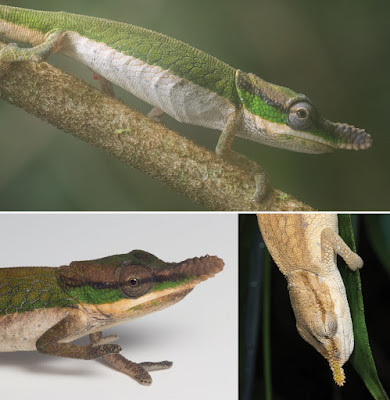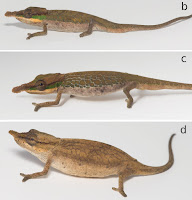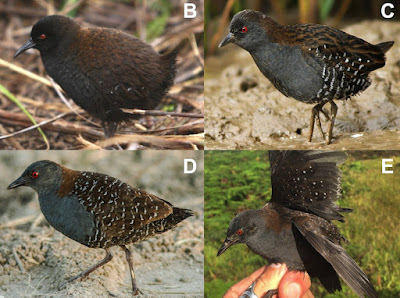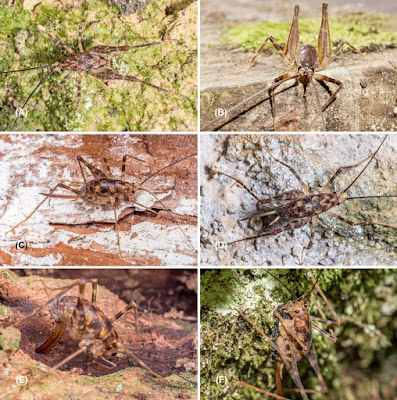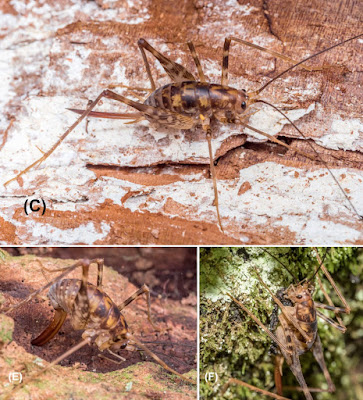[Most Recent Entries] [Calendar View]
Saturday, October 20th, 2018
| Time | Event | ||||||||||
| 5:26a | [Herpetology • 2018] Calumma roaloko • The Smallest ‘True Chameleon’ from Madagascar: A New, Distinctly Colored Species of the Calumma boettgeri complex (Squamata, Chamaeleonidae)
Abstract On a recent expedition to eastern Madagascar, we discovered a distinct new species of the genus Calumma that we describe here using an integrative approach combining morphology, coloration, osteology and molecular genetics. Calumma roaloko sp. n. has a dermal rostral appendage and occipital lobes, and belongs to the C. boettgeri complex, within the Madagascar-endemic phenetic C. nasutum species group. It is readily distinguished from other species of the C. boettgeri complex by a characteristic two-toned body coloration and small body size with a snout-vent length of 45.6 mm in an adult male. The osteology of the skull, with a prominent maxilla and broad parietal, is similar to the closest related species, C. uetzi. Analysis of uncorrected genetic distances within the C. nasutum group using the mitochondrial gene ND2 shows a minimum pairwise distance of 11.98% to C. uetzi from the Sorata massif and Marojejy National Park >500 km north of the type locality of C. roaloko sp. n.. Given an apparently small range (potentially <300 km2), located entirely outside of any nationally-protected areas, we recommend this new species be classified as Endangered under criterion B1ab(iii) of the IUCN Red List. The discovery of clearly distinct species like C. roaloko sp. n. in an area of Madagascar that is comparatively thoroughly surveyed highlights the critical role of continued field surveys for understanding the true extent of Madagascar’s spectacular biodiversity. Key Words: Calumma roaloko sp. n., Integrative taxonomy, Micro-computed tomography, Osteology, Calumma nasutum group Calumma roaloko sp. n. Suggested common English name: The two-toned soft-nosed chameleon Suggested common Malagasy name: Tanalahy roa loko Diagnosis: Calumma roaloko sp. n. is a member of the phenetic C. nasutum species group (Prötzel et al. 2016), on the basis of the presence of a soft, dermal unpaired rostral appendage, absence of gular and ventral crests, and heterogeneous scalation on the lower arm, consisting mostly of tubercles of 0.4–0.7 mm diameter. With 44.5–45.6 mm SVL and 85.5–93.7 mm total length in adult specimens it is currently the smallest known species in the genus Calumma. The body of the chameleon is uniquely two-colored with beige/white on the ventral and bright green on the dorsal half. Furthermore, it is characterized by a prominent and distally rounded rostral appendage, occipital lobes that are slightly notched, a distinctly elevated rostral crest, absence of a dorsal crest (or presence of at most two cones) in both sexes, absence of axillary pits, and a unique skull morphology. Etymology: The specific epithet “roaloko” is a combination of the Malagasy words “roa” meaning “two” and “loko” meaning “color”, in reference to the characteristic two-toned body colorations of males (green and white) and females (brown and tan) of this species. The epithet is to be treated as an invariable noun in apposition.
Natural history: The specific natural history of Calumma roaloko sp. n. is little-known, but assumed to be similar to other small-bodied Calumma. As with other C. nasutum group species, individuals of C. roaloko sp. n. were encountered sleeping at night on leaves (Fig. 7) or small branches, and most often spotted ~2–5 m above the ground. Calumma roaloko sp. n. may be restricted to higher-elevation habitats, as it has only been found at ca. 1100 m a.s.l., although this is difficult to determine with certainty as most forests below ~1000 m a.s.l. in the area have been cleared. Interestingly, it is known from only two sites, both on the periphery of the forest fragment, and characterized by qualitatively more degraded habitat and/or secondary forest growth as compared to two sites located with more intact primary forest, where it was not encountered (Fig. 4). In summary, either C. roaloko sp. n. may have a higher detection probability in disturbed habitats, and/or may be out-competed in primary forest by close relatives (e.g., C. nasutum complex species that we found in all four sites). Several specimens were observed to have small red acarid ectoparasites (visible on the hindlimb in Fig. 6a). Distribution: Given current evidence, the distribution of Calumma roaloko sp. n. is potentially restricted to a small fragment (~300 km2) of mid-elevation rainforest that lies outside of nearby Analamazaotra Special Reserve and Andasibe-Mantadia National Park in central-eastern Madagascar (Fig. 4), but within the Réserve de Ressources Naturelles du Corridor Ankeniheny-Zahamena newly protected area. However, we believe that C. roaloko sp. n. may still be discovered in nearby areas, including Andasibe-Mantadia National Park, although it has never been found over dozens of surveys in nearby protected areas over the last century, including our own surveys (Hutter, Lambert, Scherz, Prötzel, Glaw, etc. unpubl. data). It is also possible that C. roaloko sp. n. could be found in other smaller and more fragmented forests located to the west of the type locality of C. roaloko sp. n., south of the city of Moramanga, but recent work in one remnant forest fragment in that area discovered C. juliae there, and no specimens of C. roaloko sp. n. were found (Prötzel et al. 2018). David Prötzel, Shea M. Lambert, Ginah Tsiorisoa Andrianasolo, Carl R. Hutter, Kerry A. Cobb, Mark D. Scherz and Frank Glaw. 2018. The Smallest ‘True Chameleon’ from Madagascar: A New, Distinctly Colored Species of the Calumma boettgeri complex (Squamata, Chamaeleonidae). Zoosystematics and Evolution. 94(2): 409-423. DOI: 10.3897/zse.94.27305 | ||||||||||
| 10:33a | [Crustacea • 2018] Allorchestoides rosea • A New Genus and Species of Dogielinotid Amphipod (Amphipoda: Dogielinotidae) from the Nipa Palm in Thailand, with An Updated Key to the Genera
Abstract During a scientific survey, a new genus of the dogielinotid amphipoda was found in the Nipa palm (Nypa fruticans) in Bang Krachao Urban Oasis, Samut Prakan Province, Thailand. We placed this new genus, Allorchestoides gen. nov., within the family Dogielinotidae. The new taxa can be easily distinguished from the remaining genera by differences in the incisor of the left and right mandibles, apical robust setae of the maxilla 1, and the large coxa and strong obtuse palm in the female gnathopod 1. The type species of Allorchestoides gen. nov., Allorchestoides rosea n. sp., is described here in, with an updated key to the genera of the family Dogielinotidae. Order Amphipoda Latreille, 1816 Suborder Senticaudata Lowry & Myers, 2013 Family Dogielinotidae Gurjanova, 1953
Allorchestoides gen. n. Diagnosis: Male. Mouthparts, mandible, right incisor process four dentate; left incisor process six dentate; accessory setal row present; molar triturative. Maxilla 1 outer plate with six distal setal-teeth. Maxilla 2, inner plate with an enlarged proximal seta; outer plate subequal to inner plate in length. Maxilliped, outer plate shorter than article 2 of maxilliped palp; palp well-developed, dactyl unguiform. Coxal plates 1–4 deep, subrectangular; coxal plate 1–3 posterior marginal cusp absent. Gnathopods sexually dimorphic. Male gnathopod 1 weakly chelate; carpal lobe well-developed; palm slightly protruding at palmar corner, dactylus fitting palm. Gnathopod 2 propodal palm smoothly concave, interior margin lined with pappose setae. Epimeral side plates ordinary, plate 2 deepest. Pleopods peduncle with 2 small retinacula; Female. Gnathopods 1 and 2 weakly chelate; carpal lobe well-developed, surpassing over propodus. Type species: Allorchestoides rosea, new species, here designated. Etymology: The specific name, Allorchestoides, alludes to fact that the new genus is allied to Allorchestes Dana, 1849. The gender is feminine as the gender adopted by its original authors. Remarks: The new genus is similar to Allorchestes Dana, 1849, from the north and south Pacific, because it has a dactylus of maxilliped unguiform; carpus of male gnathopod 2 lobate, projecting between the merus and propodus; uropod 3 uniramus; and telson cleft that is half-length. However, the 1-articulate maxilla 1 palp in Allorchestes is reduced and tiny, not reaching the base of the setal-teeth of the outer lobe, while that of Allorchestoides gen. n. is absent.
Allorchestoides rosea n. sp. Etymology: This species is named after the distinct reddish color while the amphipod alive (Fig 2). Type locality: THAILAND, Bang Krachao Estuary near Chao Phraya River mouth (13°41'47.4"N 100°33'52.4"E), Nipa Palm leafs in mangrove forest, 2016, Dumrongrojwattana,P. Type material: Holotype. ♂, PSUZC-CR-0300. Allotype, ♀ collected with holotype;..
Koraon Wongkamhaeng , Pongrat Dumrongrojwattana, Myung‐Hwa Shin. 2018. Discovery of A New Genus and Species of Dogielinotid Amphipod (Crustacea: Amphipoda: Dogielinotidae) from the Nipa Palm in Thailand, with An Updated Key to the Genera. PLoS ONE. 13(10); e0204299. DOI: 10.1371/journal.pone.0204299 | ||||||||||
| 10:41a | [Ornithology • 2019] Atlantisia rogersi • The Origin of the World’s Smallest Flightless Bird, the Inaccessible Island Rail (Aves: Rallidae)
Highlights • Atlantisia rogersi colonized Inaccessible Island from S. America 1.5 million years ago. • Its closest relative is the Dot-winged Rail Porzana spiloptera. • The well-supported clade also contains Black Rail Laterallus jamaicensis. • We advise conservative taxonomic changes: Laterallus rogersi, L. spilopterus. • Further sampling of the ‘Laterallus clade’ required for a fully resolved phylogeny. Abstract Rails (Aves: Rallidae) are renowned for their extreme dispersal capability, which has given rise to numerous island lineages. Many insular species lost the ability to fly as a response to release from predator pressure—a feature causing rapid extinction when humans subsequently introduced mammals. The world’s smallest extant flightless bird, the Inaccessible Island Rail Atlantisia rogersi, is endemic to Inaccessible Island, Tristan da Cunha archipelago, in the central South Atlantic Ocean. It is placed in a monotypic genus, but its taxonomic affinity, as well as geographic origin, are disputed. Contrary to its suggested Old World origin, we demonstrate that the Inaccessible Island Rail is nested within the mainly South American ‘Laterallus clade’ and that it colonized ≥3 million-year-old Inaccessible Island from South America c. 1.5 million years ago. The taxonomy of rails has traditionally been based on morphology, and convergent evolution has caused many cases of misclassification. We suggest a re-classification within the ‘Laterallus clade’ and call for extended coverage of taxon sampling for DNA sequencing. Keywords: Colonization, Oceanic islands, Phylogeny, Phylogeography, Taxonomy Martin Stervander, Peter G. Ryan, Martim Melo and Bengt Hansson. 2018. The Origin of the World’s Smallest Flightless Bird, the Inaccessible Island Rail Atlantisia rogersi (Aves: Rallidae). Molecular Phylogenetics and Evolution. 130; 92-98. DOI: 10.1016/j.ympev.2018.10.007 | ||||||||||
| 11:30a | [Entomology • 2018] Reinstatement of the New Zealand Cave Wētā Genus Miotopus Hutton (Orthoptera: Rhaphidophoridae) and Description of A New Species, Miotopus richardsi
Abstract Comparison of morphological and genetic data from New Zealand forest cave wētā suggests we should recognise the genus Miotopus proposed by Hutton (1898). A new species within this genus is described (Miotopus richardsi sp. nov.). Both Miotopus diversus (Hutton, 1898) and Miotopus richardsi sp. nov. are common in native forests and widespread in New Zealand. Here we provide their known distributions and key traits Keywords: cave wētā; cave cricket; Miotopus; Pleioplectron; Rhaphidophoridae Order Orthoptera Latreille, 1793 Superfamily Rhaphidophordoidea Walker, 1869 Family Rhaphidophoridae Walker, 1869 Subfamily Macropathinae Karny, 1930 Tribe Macropathini Karny, 1930 Genus Miotopus Hutton, 1898 Medium size cave wētā (body length 11–17 mm) found in forests and caves, on three main islands of New Zealand. The genus consists of two species that are structurally quite distinct from one another, and share some morphological characteristics with Pleioplectron. .... Miotopus diversus Hutton, 1898 Diagnosis A medium sized cave wētā found in forested areas around the North Island, New Zealand, mainly in leaf litter on the forest floor, or in the roots of trees. Dark brown with visible dark and pale bands on the fore and mid legs, it could be most easily confused with the sympatric Pleioplectron hudsoni. However, adult Miotopus diversus are larger (see Table 1), usually appear darker in life, and have small spines on the dorsal surface of the mid tibiae, and are further distinguished from Pleioplectron by spine count and male terminalia. Miotopus richardsi sp. nov. Diagnosis: A medium sized cave wētā found in forested areas of the South Island, New Zealand with a variegated colour pattern. Similar to Miotopus diversus based on apical spines with the exception of the presence on hind femora of both prolateral and retrolateral apical spines (n.b. this trait was formerly considered diagnostic of Pachyrhamma, see Cook et al. 2010). It is easily identified by the very long legs and the presence of three pairs of prominent, socketed superior spines on the hind tibiae. Female with subgenital plate similar to M. diversus, but differs in male genital terminalia. Notably long ovipositor, as long as or longer than body length. Etymology: Named for Aola Richards who studied New Zealand cave wētā and published many important systematic papers from 1954 until 1972. Josephine L. Fitness, Mary Morgan-Richards, Danilo Hegg and Steven A. Trewick. 2018. Reinstatement of the New Zealand Cave Wētā Genus Miotopus Hutton (Orthoptera: Rhaphidophoridae) and Description of A New Species. European Journal of Taxonomy. 468; 1–24. DOI: 10.5852/ejt.2018.468 |
| << Previous Day |
2018/10/20 [Calendar] |
Next Day >> |
